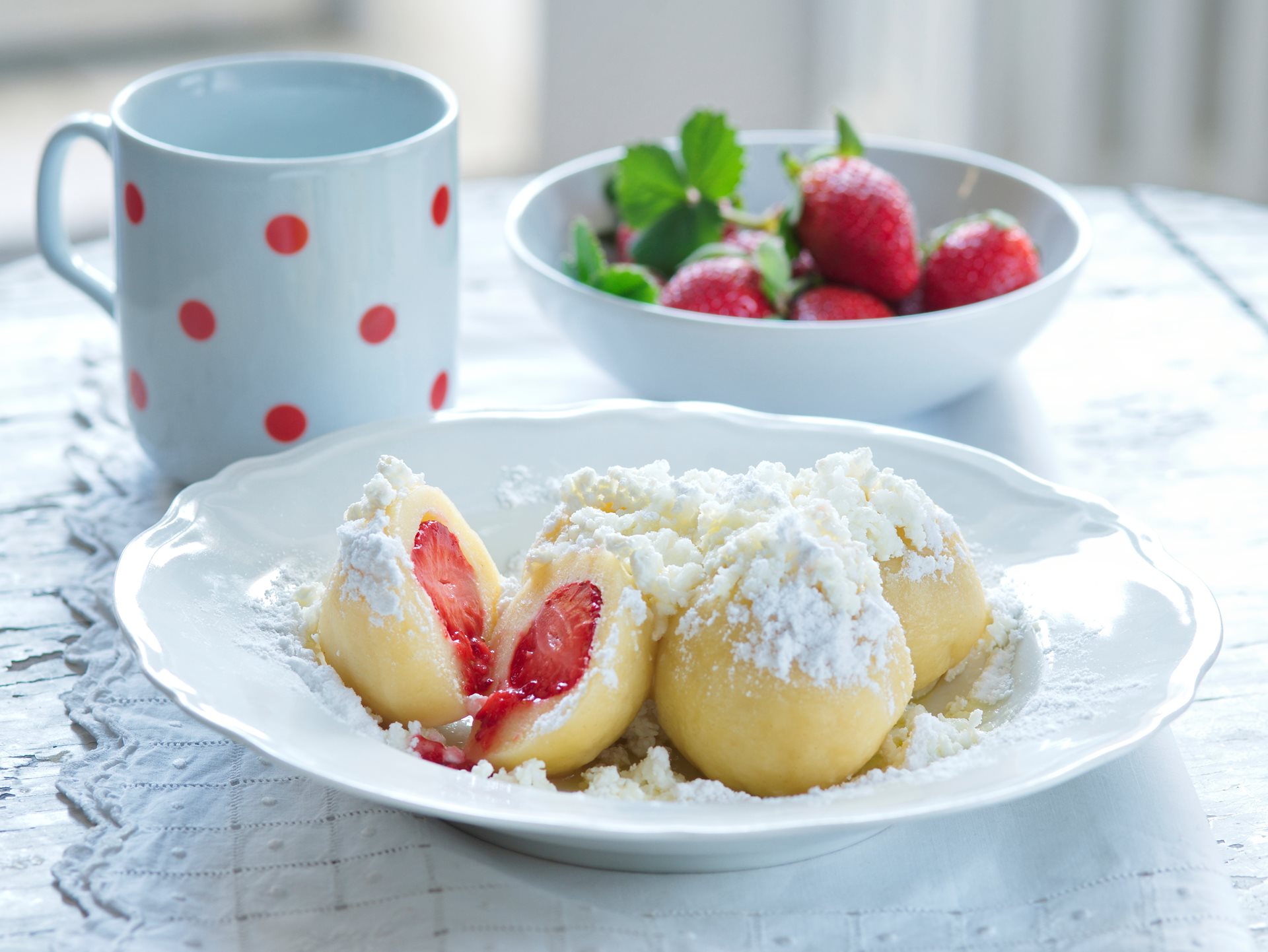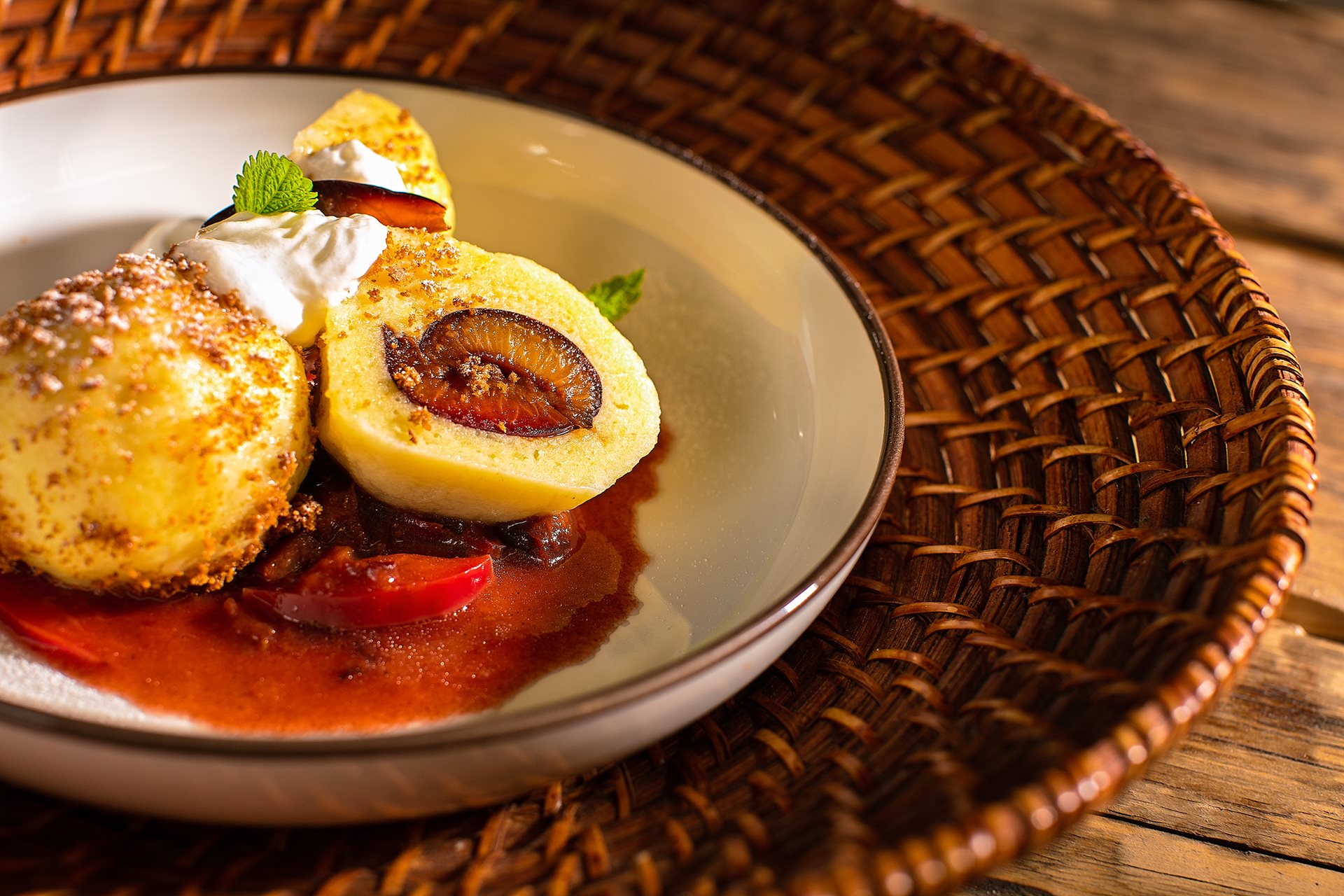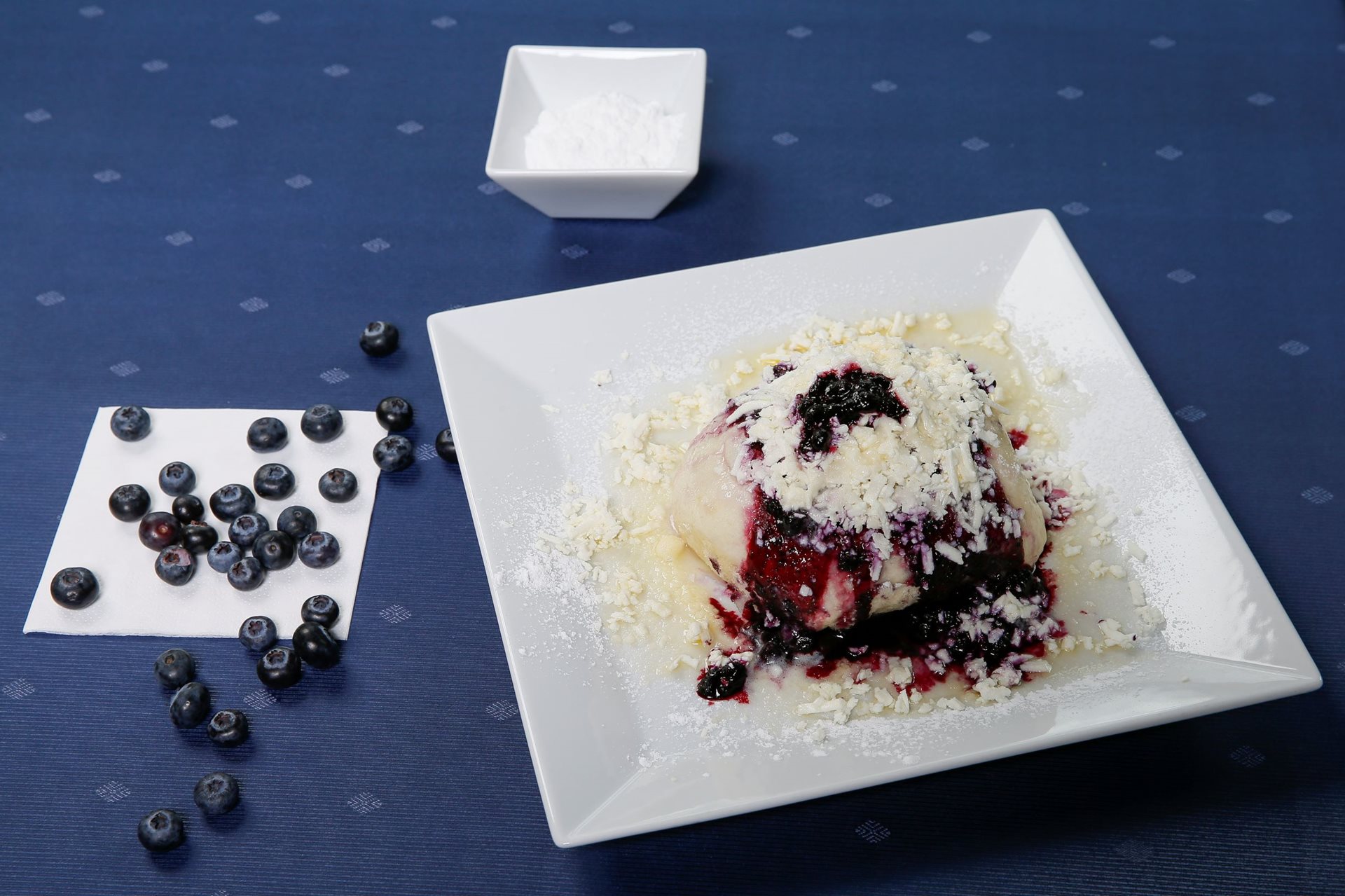If you have visited the Czech Republic without tasting the fruit dumplings, you have to go right back to make amends. The fruit dumpling is a traditional Czech specialty, with a few typical characteristics, which primarily comprise their seasonality and the different ways they are served in different regions.
In Bohemia, the dumpling first appeared in the 12th century, then called “šiška”; the current Czech name comes from the German word Knödel. Recipes for bread or potato dumplings were written down as early as in the first half of the 17th century. Fruit dumplings were also first mentioned in the same era, called sweet balls. However, in those days, they used to be stuffed with plums and fried. Poached dumplings as we know them today first appeared on Czech plates a hundred years later.
While you will not find a sweet dish served for dinner in most of Europe, people in Bohemia and Moravia enjoy sweet meals such as fruit dumplings, for lunch or dinner, from spring to winter. Even though fruit dumplings are in season year-round in the Czech Republic, they are best in summer when there is abundance of fresh fruit.

Paradoxically, the gourmet year of fruit dumplings starts with a vegetable; the first excellent, lightly sour dumplings of the year are made with rhubarb in Moravia. As soon as the first strawberries start to ripen, you can get strawberry dumplings, shortly followed by apricot dumplings. Small summer fruit, such as gooseberry and black currant, is also a great filling in sweet dumplings. However, blueberries are definitely the favourite, followed by plums, which were basically the pioneers of sweet dumpling filling. Plum dumplings are probably the most famous in the world. For example, Edouard de Pomiane, a famous French chef and gourmet of Polish origin, said that plum dumplings are one of the ten best meals in the world. But the dumpling season goes on; when there are no apples or pears available, they are filled with plum butter, or even with chocolate or marzipan.
Just like most typical Czech meals, fruit dumpling recipes are also based on ingredients that are regionally abundant. In regions where cows were bred, providing enough milk, dumplings were made of cottage cheese dough, and they were also topped with grated cottage cheese. Richer families poured cream, sweet or sour, over the dumplings.
Where potatoes were grown, fruit was wrapped in potato dough, and dumplings were usually topped with poppy seeds, grated gingerbread or breadcrumbs fried in butter.

600 g boiled, unpeeled potatoes, 50 g semolina, 200 g coarse meal, 1 egg,
a pinch of salt, 500 g plums, 100 g powdered sugar, 100 g grated gingerbread, 150 g butter
How to make it:
When the potatoes cool down, peel them and grate them finely. Add a pinch of salt, egg, semolina, sifted coarse meal and create a firm dough. Roll the dough into a thin layer, cut into squares of about 4x4 cm, and place rinsed, pitted and well dried plums in the squares. Carefully wrap the plums and shape the dumplings. Place the dumplings into boiling, lightly salted water and immediately stir them, carefully, to prevent them sticking to the bottom. As soon as they rise up, take them out of the water with a sieve or slatted spoon, let the water drain and serve topped with grated gingerbread, powdered sugar and melted butter.
To this day, people in the poorest regions, mostly in the mountains and foothills, make the largest dumplings from yeasted dough; one huge dumpling served on a plate instead of a few small ones. In the old days, it was to get full. Since there was abundance of forest fruit, blueberries and raspberries, dumplings were not only filled with fruit, but also topped with a fruit sauce.

400 g semi-coarse flour, 15 g caster sugar, a pinch of salt, 40 g fresh yeast, 200 ml milk, 1 egg, 200 g blueberries
Sauce ingredients and to serve
200 g blueberries (also frozen), 1/2 lemon, 20 g caster sugar, a teaspoon of potato starch, cottage cheese for grating, butter, powdered sugar
How to make it:
Put the flour and salt in a bowl and mix. Make a hole in the middle and crumble the yeast in the hole. Sprinkle some sugar on top, add a little lukewarm milk and let the yeast rise. Then add the remaining milk, egg and work the dough. Let it rise in a warm place for about 30 minutes. When the dough is ready, divide it into four parts. Flatten each part, fill with blueberries, shape it into a dumpling and let it rise for about 15 minutes. Then place the dumplings into boiling salted water. Boil for about 5 minutes on one side and 3 minutes on the other side. When cooked, pierce them with a fork to let the steam escape and prevent their shrinking.
For the sauce, put the blueberries, lemon juice and sugar in a pot and leave to boil. Meanwhile, mix the starch with some water. Slowly add the mixed starch into the boiling blueberries to thicken the sauce to your liking. When serving, break the dumpling in the middle, pour the sauce over it, top with grated cottage cheese and sugar and pour melted butter on the dumpling.
The Czechs, small or large, love fruit dumplings, and they even organise fruit dumpling eating competitions. The 2018 record from Vizovice has not yet been broken as the winner ate an unbelievable 202 plum dumplings.
Whether you have the Czech fruit dumplings as a main meal or a dessert, you will definitely enjoy them! Find the best Czech cuisine at www.czechspecials.cz.
While you will not find a sweet dish served for dinner in most of Europe, people in Bohemia and Moravia enjoy sweet meals such as fruit dumplings, for lunch or dinner, from spring to winter. Even though fruit dumplings are in season year-round in the Czech Republic, they are best in summer when there is abundance of fresh fruit.

Paradoxically, the gourmet year of fruit dumplings starts with a vegetable; the first excellent, lightly sour dumplings of the year are made with rhubarb in Moravia. As soon as the first strawberries start to ripen, you can get strawberry dumplings, shortly followed by apricot dumplings. Small summer fruit, such as gooseberry and black currant, is also a great filling in sweet dumplings. However, blueberries are definitely the favourite, followed by plums, which were basically the pioneers of sweet dumpling filling. Plum dumplings are probably the most famous in the world. For example, Edouard de Pomiane, a famous French chef and gourmet of Polish origin, said that plum dumplings are one of the ten best meals in the world. But the dumpling season goes on; when there are no apples or pears available, they are filled with plum butter, or even with chocolate or marzipan.
Different region, different dumpling
If you think that you will find the same dumplings all over Bohemia and Moravia, you are wrong. The dough as well as fruit changes from region to region, as do the toppings.Just like most typical Czech meals, fruit dumpling recipes are also based on ingredients that are regionally abundant. In regions where cows were bred, providing enough milk, dumplings were made of cottage cheese dough, and they were also topped with grated cottage cheese. Richer families poured cream, sweet or sour, over the dumplings.
Where potatoes were grown, fruit was wrapped in potato dough, and dumplings were usually topped with poppy seeds, grated gingerbread or breadcrumbs fried in butter.

Potato dumplings with plums, topped with gingerbread
Ingredients (serves 4):600 g boiled, unpeeled potatoes, 50 g semolina, 200 g coarse meal, 1 egg,
a pinch of salt, 500 g plums, 100 g powdered sugar, 100 g grated gingerbread, 150 g butter
How to make it:
When the potatoes cool down, peel them and grate them finely. Add a pinch of salt, egg, semolina, sifted coarse meal and create a firm dough. Roll the dough into a thin layer, cut into squares of about 4x4 cm, and place rinsed, pitted and well dried plums in the squares. Carefully wrap the plums and shape the dumplings. Place the dumplings into boiling, lightly salted water and immediately stir them, carefully, to prevent them sticking to the bottom. As soon as they rise up, take them out of the water with a sieve or slatted spoon, let the water drain and serve topped with grated gingerbread, powdered sugar and melted butter.
To this day, people in the poorest regions, mostly in the mountains and foothills, make the largest dumplings from yeasted dough; one huge dumpling served on a plate instead of a few small ones. In the old days, it was to get full. Since there was abundance of forest fruit, blueberries and raspberries, dumplings were not only filled with fruit, but also topped with a fruit sauce.
Blueberry dumpling with blueberry sauce (žahour)
Dumpling ingredients:400 g semi-coarse flour, 15 g caster sugar, a pinch of salt, 40 g fresh yeast, 200 ml milk, 1 egg, 200 g blueberries
Sauce ingredients and to serve
200 g blueberries (also frozen), 1/2 lemon, 20 g caster sugar, a teaspoon of potato starch, cottage cheese for grating, butter, powdered sugar
How to make it:
Put the flour and salt in a bowl and mix. Make a hole in the middle and crumble the yeast in the hole. Sprinkle some sugar on top, add a little lukewarm milk and let the yeast rise. Then add the remaining milk, egg and work the dough. Let it rise in a warm place for about 30 minutes. When the dough is ready, divide it into four parts. Flatten each part, fill with blueberries, shape it into a dumpling and let it rise for about 15 minutes. Then place the dumplings into boiling salted water. Boil for about 5 minutes on one side and 3 minutes on the other side. When cooked, pierce them with a fork to let the steam escape and prevent their shrinking.
For the sauce, put the blueberries, lemon juice and sugar in a pot and leave to boil. Meanwhile, mix the starch with some water. Slowly add the mixed starch into the boiling blueberries to thicken the sauce to your liking. When serving, break the dumpling in the middle, pour the sauce over it, top with grated cottage cheese and sugar and pour melted butter on the dumpling.
The Czechs, small or large, love fruit dumplings, and they even organise fruit dumpling eating competitions. The 2018 record from Vizovice has not yet been broken as the winner ate an unbelievable 202 plum dumplings.
Whether you have the Czech fruit dumplings as a main meal or a dessert, you will definitely enjoy them! Find the best Czech cuisine at www.czechspecials.cz.
